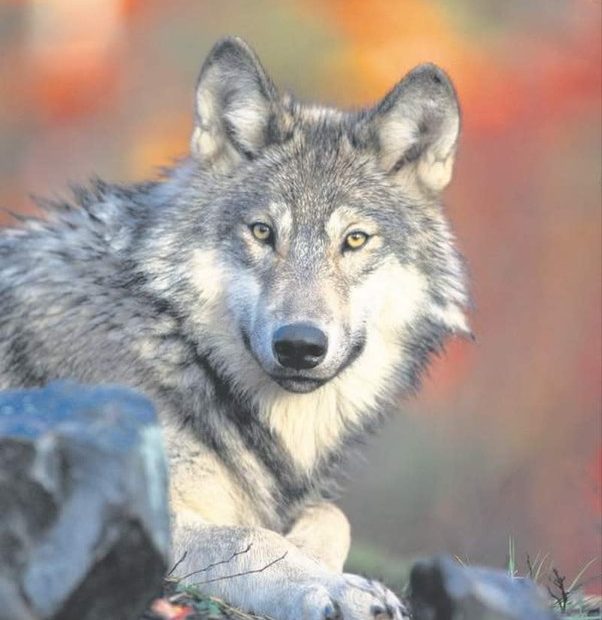
Will some Northwest wolves call Colorado home?
Listen
(Runtime 1:01)
Read
Northwest wolves could soon be on their way to Colorado. Wildlife managers there say they need to bring wolves to their state, after wolves were wiped out by the 1940s. So, they’ve turned to the Northwest for help. But so far, that help hasn’t materialized.
A 2020 proposition in Colorado that passed and is now a state law requires the state to start reintroducing wolves by the end of this year.
Although a few wolves have wandered into Colorado from neighboring areas, it’s not enough to sustain a population, which is why wildlife managers hope to pack up several wolves from other states and resettle them along Colorado’s Western Slope.
There are no official estimates of the number of wolves in Colorado, although wildlife managers say there could be at least six in the state.
“It’s been way too long, a century essentially, since Colorado had a population of wolves,” said Michael Robinson, senior conservation advocate with the Center for Biological Diversity.
Some studies suggest bringing wolves into areas where they’ve been wiped out can make the natural landscape healthier.
In a move to bring wolves back, Colorado sent letters requesting talks with wildlife officials in Washington, Montana, Idaho and Oregon.
If no state steps up, Colorado Parks and Wildlife spokesperson Travis Duncan said Colorado will exhaust all options to reintroduce wolves.
The clock is running out, though. Colorado would like to begin moving wolves in mid-to late-December.
In a letter sent to Washington’s Fish and Wildlife director, Colorado Parks and Wildlife Director Jeff Davis laid out his department’s initial ask: They would like to bring in 10-15 wolves, likely from various states, over a period of three to five years. That would be 30-50 wolves in all.
“For the states that have both federally listed and delisted populations, we would only be looking to acquire wolves from the federally delisted portion of your state,” Davis wrote in the May 15 letter.
In Washington, that would be the eastern third of the state, where most wolves call home.
The Washington Fish and Wildlife Commission briefly discussed the proposal at its last meeting. The commissioners voted to request the department’s director, Kelly Susewind, respond to the letter. They asked that, at some point, he make it clear now might not be the right time to help out.
“This isn’t really anything we’re that enthusiastic about,” Commissioner Barbara Baker said during the June 23 meeting. “But we do want to hear more [about the proposal.]”
Right now, Washington officials are in the middle of a periodic status review for wolves. The state will accept public comments on its draft review through Aug. 16. The most recent wolf count found at least 216 wolves in the state, 37 known packs and 26 breeding pairs.
Wolves wandered into Washington from Oregon and Idaho. The first breeding pair was spotted in 2008. Historically, wolves roamed much of the state but people wiped them out by the 1930s.
Now, wolves in Washington are protected under the federal Endangered Species Act in the western two-thirds of the state. In the eastern third of the state, wolves are protected under the state Endangered Species Act.
For wolf relocation to Colorado, the Oregon Department of Fish and Wildlife is planning more discussions about the proposal, said spokesperson Michelle Dennehy.
In Oregon, the state documented at least 178 wolves in 2022, increasing very slightly from the previous two years.
Wolves are protected as a special status game mammal in Oregon. They were delisted from the Oregon’s Endangered Species List in 2015, but wolves are not allowed to be hunted. Wolves in the western two-thirds of Oregon (officially listed as west of Highways 395, 78 and 95) are protected under the federal Endangered Species Act.
Colorado officials suggested the best places to get wolves would be the Northern Rockies in Idaho and Montana, although they said Washington and Oregon wolves would also work. So far, Idaho and Montana officials have declined the proposal or aren’t “in conversations,” according to spokespeople.
“We wanted to take wolves that currently are heavily persecuted and give them a new chance in Colorado,” Robinson said, which he said is why his group suggested first moving wolves from Montana and Idaho.
But Idaho officials said they won’t send wolves south. They cited current litigation, Endangered Species Act constraints and social strains among rural communities, hunters and wolf advocates.
In a June 6 letter, Idaho Department of Fish and Game Director Jim Fredericks wrote he worried wolves relocated to Colorado would not stay in Colorado – and neither would any future lawsuits.
“Idaho is concerned with expanding the scope of our biological and social conflicts regarding wolves rather than reducing them,” Fredericks wrote.
In 2022, Idaho’s wolf population dropped by 13% to an estimated 1,337 wolves in the state.
“Wolf population reduction has been a priority of the Fish and Game Commission,” said Ed Schriever, formerly with Fish and Game, in a news release. “There’s been a concerted effort by Fish and Game staff, hunters, trappers and other partners and agencies to reduce wolf conflicts with livestock and bring the wolf population in balance with prey species, particularly elk.”
Montana officials said the state’s Department of Fish, Wildlife and Parks isn’t considering translocating wolves at this time.
“We are not in any conversation about translocating wolves anywhere,” said Fish, Wildlife and Parks spokesperson Greg Lemon.
In Montana, wolf recovery began in the 1980s. Now, the wolf population is relatively stable around 1,160 wolves, mostly in the western half of the state, Lemon said. Average harvest over the past five years has been around 289 wolves.
Still, Colorado officials say they’re hopeful.
“We anticipate that we will find a solution in time to release wolves prior to the Dec. 31, 2023 deadline,” spokesperson Travis Duncan said in an email.
















